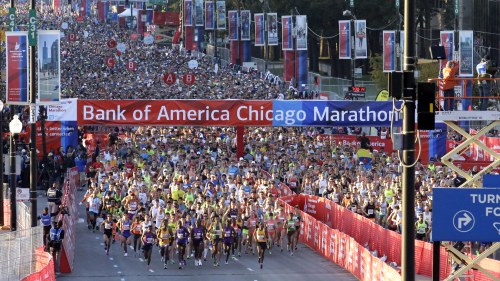Runners from more than 140 countries participated in the Chicago Marathon

The Bank of America Chicago Marathon continues to generate significant economic benefits for Chicago, thanks to its unique characteristics and international reputation.
Every October, thousands of runners participate in a 26.2-mile trek through 29 neighborhoods to the cheers of more than 1.7 million spectators for the Bank of America Chicago Marathon. This weekend, the city played host to more than 47,000 runners — a historic high — from all 50 states and more than 140 countries, including Australia, Singapore, and India.
“Running and marathon running has grown popular globally, and people want to participate in the Chicago Marathon — this is one of the grand stops for world marathon running,” said Carey Pinkowski, executive race director of the Bank of America Chicago Marathon. Pinkowski added that he believes the number of international runners participating in the marathon will continue to grow in the coming years.
Last year, 33% of participants were international, similar to this year. But it’s difficult to compare years due to the COVID-19 pandemic. In 2020, the Chicago Marathon was cancelled — just the second time in its 45-year history. And in 2021, the same year several countries including Canada and the U.K., which tend to have a strong presence in the race, were restricting non-essential travel to the U.S., race officials had to limit the field to 25,000 participants.
Why Chicago?
It isn’t just the cool weather that attracts runners to the Chicago Marathon. According to Pinkowski, it’s a “flat and fast course” that’s convenient for runners and spectators — the race begins and ends in the same place, which is different from the Boston and New York marathons. It's also very easy to get around on public transportation. The South Shore Line, Metra, and the CTA increase services the week of the race to make the region, city, and even the racecourse more accessible.
“Nothing compares to the Chicago Marathon,” said runner Kassoum Doumbia, who moved to Chicago from Mali in 2012. “Every crowd is different. From downtown to the North Side — Halsted, Pilsen, Chinatown, Bronzeville — it’s amazing! You don’t tend to get bored or think, ‘Why did I sign up to run a marathon?’ because the crowd keeps you going.”
Subscribe to ChicagoGlobal
This story first appeared in the ChicagoGlobal newsletter, a joint project of Crain's Chicago Business and the Chicago Council on Global Affairs.
Pinkowski says the global aspect of the marathon is also unique. The country with the largest international participation is Mexico, and the race route runs right through the heart of Pilsen. “That neighborhood comes out to celebrate their Mexican heritage and it turns into a big party,” said Pinkowski. Chicago’s strong Sister Cities program also means several other countries come out to represent their culture and support the runners.
“Strangers give you food. They’ll make peanut butter and jelly. In Pilsen, they give you mini tacos. In Chinatown, they give you shots of soy sauce — sodium — to give you a boost to finish. Other places don’t really do that,” said Doumbia, who also completed his seventh Chicago Marathon today, representing the Black Chicago Runners and Men Run Deez Streets running groups.
Pinkowski added that many participants have never been to the Windy City before running the race. After visiting, they’ve expressed amazement over the beauty of Lake Michigan, the city’s architecture scene, the diversity of the neighborhoods, and even the restaurants.
Economic impact of the marathon
The event provides benefits to the Chicago community well beyond race weekend. Last year, the marathon generated $386 million, according to an economic study conducted by the University of Illinois Urbana-Champaign's Regional Economics Applications Lab.
The study also showed more than $163 million was spent on the city’s tourism sector, with an average visitor spending $664 a day on accommodations, shopping, food, transportation, and entertainment combined. This equated to 2,848 full-time jobs and $136.6 million worth of salary income and wages.
By comparison, the economic impact of music festival Lollapalooza this year showed the event generated more than $422 million, compared to $322 million last year.
Beyond the economic impact of the marathon, Chicago also saw more than 10,000 charity runners “raise a record-breaking $27.6 million for 180 worthy causes last year,” said Pinkowski. This year, it’s projected to exceed $30 million, he said.
This story first appeared in the ChicagoGlobal newsletter, a joint project of Crain's Chicago Business and the Chicago Council on Global Affairs. Subscribe today.

